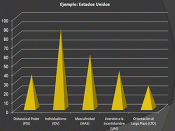Geert Hofstede gathered data from 53 different national cultures. The study revealed that the 53 countries differed along four cultural dimensions; power distance, Individualism - collectivism, masculinity - femininity, and uncertainty avoidance. (R. N. Sanyal, 2001) Power Distance reflects the degree to which a culture believes how institutional and organizational power should be distributed and how the decisions of the power holders should be viewed In other words, people in high power distance cultures are much more comfortable with a larger status differential than low power distance cultures. Individualism-Collectivism describes the degree to which a culture relies on and has allegiance to the self or the group. Masculinity- indicates the degree to which a culture values such behaviors as assertiveness, achievement, acquisition of wealth or caring for others, social supports and the quality of life. This dimension tends to draw unwarranted criticism for its name alone. It basically refers expected gender roles in a culture.
According to Hofstede, people in high masculinity believe in achievement and ambition, in ostentatious manliness, with very specific behaviors and products associated with male behavior. The cultures that scored towards what Hofstede referred to as masculine tend to have very distinct expectations of male and female roles in society. Low masculinity cultures believe less in external achievements and/or manliness, and more in quality of life such as helping others and sympathy for the unfortunate. Feminine cultures also prefer equality between male and female and less prescriptive role behaviors associated with each gender. The more feminine cultures have a greater ambiguity in what is expected of each gender. Uncertainty Avoidance refers to the extent to which a culture feels threatened by ambiguous, uncertain situations and tries to avoid them by establishing more structure. The high positive scores on the uncertainty avoidance index indicate low tolerance for...


